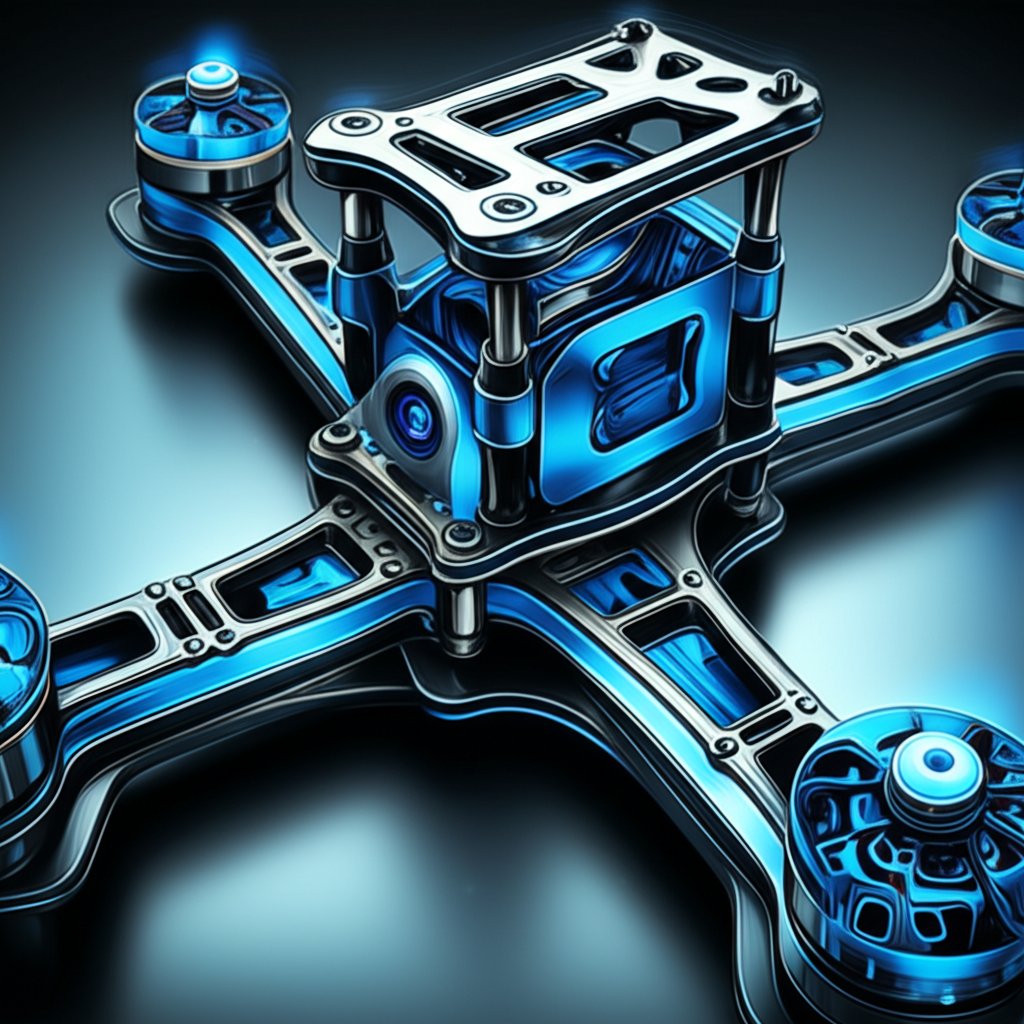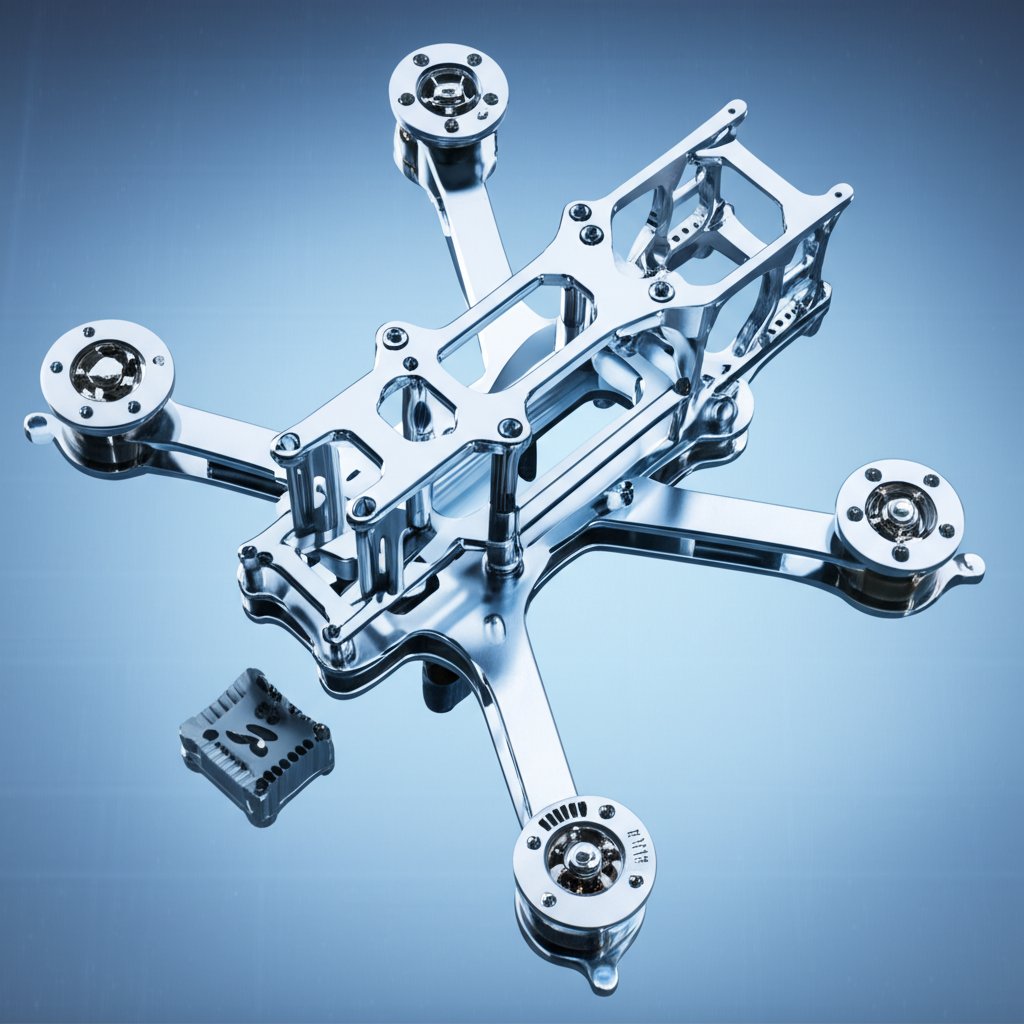Unlock Drone Performance with CNC Machining for Parts

TL;DR
CNC machining is a high-precision, subtractive manufacturing process essential for creating durable, high-performance drone parts. By carving components from solid blocks of materials like aerospace-grade aluminum and carbon fiber, it produces parts with exceptionally tight tolerances. This precision directly improves a drone's flight stability, structural integrity, and overall reliability, making it the superior choice for critical components where performance cannot be compromised.
Why CNC Machining is Crucial for High-Performance Drones
In the rapidly advancing world of unmanned aerial vehicles (UAVs), performance is dictated by precision. While additive manufacturing methods like 3D printing build parts layer by layer, CNC (Computer Numerical Control) machining takes a subtractive approach, precisely removing material from a solid block to achieve the final design. This method offers a level of accuracy and material integrity that is often essential for the demanding conditions drones face. The process translates a digital CAD model into instructions for cutting tools, ensuring every component is manufactured to exact specifications, a critical factor for flight stability and performance.
The primary advantage of using CNC machining for drone parts lies in the significant improvements to performance and durability. The micron-level precision of CNC machines ensures that components like motor mounts and propeller hubs are perfectly balanced and fit together flawlessly. According to an analysis by Boona Prototypes, this precision minimizes in-flight vibrations, leading to enhanced stability crucial for applications like aerial photography or high-speed racing. The ability to produce parts with tight tolerances guarantees that every component functions exactly as intended, improving the drone's overall reliability and safety.
Furthermore, the structural integrity of CNC-machined parts is unparalleled. Components milled from a single piece of aluminum or titanium are inherently stronger than their molded or printed counterparts, which can have weak points between layers. This superior strength allows drones to carry heavier payloads, withstand hard landings, and operate in harsh environmental conditions without succumbing to mechanical stress. This makes CNC machining the go-to method for mission-critical and high-performance drone applications.
Key Benefits of CNC Machining for Drones:
- Exceptional Precision: CNC machines produce parts with extremely tight tolerances, ensuring perfect alignment and balance. This minimizes vibrations and enhances flight stability, which is critical for smooth operation.
- Superior Strength and Durability: Using materials like aerospace-grade aluminum, titanium, and carbon fiber, CNC machining creates robust components that can endure significant stress and impact, extending the drone's operational lifespan.
- Material Versatility: The process is compatible with a wide range of high-strength, lightweight materials that are not always suitable for 3D printing, giving designers more options to optimize performance.
- Enhanced Reliability: The consistency and repeatability of CNC machining mean that every part is identical, simplifying assembly and ensuring predictable performance across a fleet of drones.
Critical Drone Components Manufactured via CNC
The superior characteristics of CNC machining make it the ideal manufacturing process for a variety of essential drone components where precision and strength are paramount. These parts form the backbone of the aircraft, and their quality directly impacts flight characteristics, safety, and longevity. Manufacturers like Xometry regularly produce a wide array of custom drone parts, from prototypes to end-use components for military, commercial, and racing drones.
The drone's frame is arguably the most critical structural component, and CNC machining allows for the creation of unibody frames from a single block of aluminum or carbon fiber. This approach, detailed by KDMfab, results in a frame that is exceptionally rigid and durable, providing a stable platform for all other components. Motor mounts are another key application; they must hold the motors in perfect alignment to prevent vibrations that could disrupt flight sensors. CNC-machined mounts guarantee this alignment and offer superior heat dissipation compared to plastic alternatives.
Other common parts include propeller hubs, landing gear, brackets for mounting sensors and cameras, and gimbal components. Each of these parts benefits from the tight tolerances and strength offered by CNC machining. For instance, a precisely machined gimbal ensures smooth, stable footage, while robust landing gear can absorb the impact of repeated landings without failing. The ability to machine complex geometries also allows for designs optimized for aerodynamics and weight reduction.
Below is a table outlining common CNC-machined drone parts and the materials typically used for them:
| Component | Function | Common Materials |
|---|---|---|
| Frame / Arms | Provides structural integrity and holds all components together. | Carbon Fiber, Aluminum (6061, 7075), Titanium |
| Motor Mounts | Securely attaches motors to the frame and helps dissipate heat. | Aluminum, Titanium |
| Propeller Hubs/Adapters | Ensures propellers are perfectly centered and balanced for smooth rotation. | Aluminum |
| Landing Gear | Absorbs impact during landing and provides a stable base. | Aluminum, Carbon Fiber, Titanium |
| Gimbal Brackets | Holds camera and sensor equipment, requiring vibration-free stability. | Aluminum |
| Heatsinks | Dissipates heat from electronics like ESCs and flight controllers. | Aluminum |

Choosing the Right Material: Metals, Composites, and Plastics
Selecting the appropriate material is a critical step in designing high-performance drone parts, as it directly influences the drone's weight, strength, durability, and cost. CNC machining offers the flexibility to work with a diverse palette of aerospace-grade materials, each with unique properties suited for different applications. The choice often involves a trade-off between strength-to-weight ratio, cost, and machinability.
Aluminum alloys, such as 6061 and 7075, are a popular choice due to their excellent strength-to-weight ratio, corrosion resistance, and relative affordability. They are commonly used for frames, arms, motor mounts, and other structural components. Titanium offers an even higher strength-to-weight ratio and superior durability, making it ideal for high-stress parts like landing gear or critical fasteners, though it comes at a higher cost. Carbon fiber is prized for being incredibly lightweight yet extremely rigid, making it the top choice for racing drone frames and propellers where minimizing weight is the primary goal. As noted by service providers like Elimold, this material is excellent for vibration damping, which contributes to smoother flight and clearer video footage.
Beyond metals and composites, advanced engineering plastics also have a place. Materials like Delrin (POM) and PEEK offer good mechanical strength, low friction, and are lighter than aluminum, making them suitable for components like gear parts or insulating brackets. However, it's also important to know which materials are unsuitable. As noted in public FAQs, materials that are too soft or flexible, like rubber and some polymers, or extremely hard materials like ceramics, generally cannot be CNC machined effectively.
Here is a comparison of the most common materials used for CNC-machined drone parts:
| Material | Pros | Cons |
|---|---|---|
| Aluminum (6061/7075) | Excellent strength-to-weight ratio, cost-effective, good thermal conductivity, corrosion resistant. | Heavier than carbon fiber, can bend on severe impact. |
| Titanium | Supreme strength and durability, excellent corrosion resistance, lightweight for its strength. | Significantly more expensive and difficult to machine. |
| Carbon Fiber | Extremely high strength-to-weight ratio, very rigid, excellent vibration damping. | Can be brittle and splinter on impact, more complex to machine, conductive. |
| Engineering Plastics (PEEK, Delrin) | Lightweight, good wear resistance, non-conductive, lower cost. | Lower strength and stiffness compared to metals and carbon fiber. |
Selecting a CNC Machining Partner for Your Drone Parts
Choosing the right manufacturing partner is as critical as the design and material selection for your drone project. A capable partner not only delivers high-quality parts but also provides valuable expertise that can optimize your design for manufacturability, potentially reducing costs and improving performance. When evaluating potential suppliers, it's essential to look beyond just the price and consider their technical capabilities, quality control processes, and overall service.
For projects ranging from initial concepts to functional testing, a partner offering comprehensive formative manufacturing services can be invaluable. For instance, you can accelerate your product development with a provider like XTJ's comprehensive formative manufacturing services, your trusted partner for high-quality rapid prototypes. Such partners offer rapid turnarounds, a wide selection of materials, and crucial Design for Manufacturability (DFM) feedback from an expert engineering team. Look for certifications like ISO 9001:2015, which indicates a commitment to rigorous quality control throughout the production process.
Key factors to consider include the partner's machine capabilities—do they offer 3-axis, 4-axis, and 5-axis CNC machining? 5-axis machining allows for the creation of more complex geometries in a single setup, which can improve accuracy and reduce costs. Inquire about their range of available materials and their experience with the specific material you intend to use, especially composites like carbon fiber which require specialized expertise. Additionally, consider their available finishing options, such as anodizing or powder coating, which can enhance durability and appearance.
Finally, communication and lead times are crucial. A good partner will be responsive, provide clear quotes, and offer realistic production timelines. Before committing, prepare a detailed CAD file and request a quote to evaluate not just the cost, but the entire service experience.
Checklist for Choosing a CNC Partner:
- Technical Capabilities: Do they have 3, 4, and 5-axis machines? What are their tolerance capabilities?
- Material Expertise: Do they stock and have experience with your desired materials (e.g., aerospace aluminum, carbon fiber)?
- Quality Assurance: Are they certified (e.g., ISO 9001, AS9100D)? What are their inspection and quality control processes?
- Finishing Services: Do they offer anodizing, powder coating, or other post-processing services?
- Lead Time and Cost: Are their quotes competitive and are their stated lead times reliable?
- Design Support: Do they offer Design for Manufacturability (DFM) feedback to help optimize your parts?

Frequently Asked Questions
1. How much does it cost to have something CNC machined?
The cost of CNC machining varies significantly based on several factors. These include the complexity of the part's geometry, the type and cost of the material being used, the total number of parts being produced (quantity), and the required precision or tolerances. A simple aluminum part made in high volume will be much cheaper per unit than a complex, single-prototype titanium part.
2. What materials cannot be CNC machined?
While CNC machining is versatile, some materials are not suitable. These typically include very soft or flexible materials like silicone rubber and soft polymers that cannot be held rigidly. Extremely hard or brittle materials like ceramics and hardened glass are also challenging and require specialized grinding processes. Finally, some composites may require specific tooling and techniques to avoid delamination.
3. How to make drone components?
Drone components can be made using various methods, including CNC machining, 3D printing, and injection molding. CNC machining is preferred for structural parts requiring high strength and precision, such as frames, motor mounts, and landing gear. 3D printing is excellent for rapid prototyping and complex, lightweight parts like enclosures, while injection molding is cost-effective for producing large quantities of plastic parts like propellers.
4. Will CNC machining be taken over by AI?
AI is becoming a powerful tool in manufacturing, capable of optimizing toolpaths and improving efficiency. However, it is unlikely to completely replace human expertise in the near future. The complexity of CNC programming, strategic problem-solving, and hands-on setup still require the skills of experienced programmers and machinists. AI will likely augment their capabilities, acting as a smart assistant rather than a full replacement.





